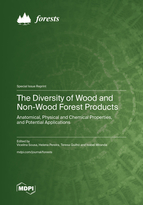The Diversity of Wood and Non-Wood Forest Products: Anatomical, Physical and Chemical Properties, and Potential Applications
A special issue of Forests (ISSN 1999-4907). This special issue belongs to the section "Wood Science and Forest Products".
Deadline for manuscript submissions: closed (1 March 2023) | Viewed by 19566
Special Issue Editors
Interests: wood anatomy; tree growth; wood products; non-wood forest products; wood technology; tree ecology; mediterranean Quercus species; forest research
Special Issues, Collections and Topics in MDPI journals
Interests: biomass; biorefineries; non-wood products; forest-based industries; natural products; circular economy
Special Issues, Collections and Topics in MDPI journals
Interests: anatomy and variability of bark and wood; leaves, roots, potential uses; ecophysical studies
Interests: biorefineries; non-wood products; natural products; biomass; tree growth
Special Issues, Collections and Topics in MDPI journals
Special Issue Information
Dear Colleagues,
A present and urgent challenge is to follow the major guidelines set out for forest resources sustainability management in the context of both ecosystem-related global warming threats and green-economy needs. For instance, we may need to pay special attention to threatened species and lesser-known endemic species, as well as to invasive species that may be profitable when managed, so as to avoid the overexploitation of current forest species. Additionally, the full resource-use approach requires consideration of the residual materials from forest management and related industries, taking into account different tree components and non-wood products that present enormous diversity.
Specific knowledge on these diverse materials regarding their structure, anatomy, and properties is, therefore, an essential tool in assessing the potential and suitability of these different forest resources. For the most profitable forest species, research over the years has produced a number of studies related to general wood-growth tendencies and characteristics. However, different species might need to be involved in the framework of new ecosystem-oriented approaches for sustainable resource management. The high diversity within and between species also requires careful study of their variability, which may contribute toward understanding their properties and potential applications, thereby supporting improved tree selection and breeding programs.
This Special Issue aims to gather research-based data on wood as well as on non-wood forest products, with special emphasis on bark—specifically its anatomical, physical, and chemical properties and their relationships—to provide tools and background information to assess the forest-resource potential of different species. Our aim is twofold, as we look to contribute to the efforts of increasing forest sustainability and diversity by preserving species with potential for high-quality end use, and to diversify wood supply using knowledge related to wood and non-wood characteristics, and their diversity.
Dr. Vicelina Sousa
Prof. Dr. Helena Pereira
Dr. Teresa Quilhó
Dr. Isabel Miranda
Guest Editors
Manuscript Submission Information
Manuscripts should be submitted online at www.mdpi.com by registering and logging in to this website. Once you are registered, click here to go to the submission form. Manuscripts can be submitted until the deadline. All submissions that pass pre-check are peer-reviewed. Accepted papers will be published continuously in the journal (as soon as accepted) and will be listed together on the special issue website. Research articles, review articles as well as short communications are invited. For planned papers, a title and short abstract (about 100 words) can be sent to the Editorial Office for announcement on this website.
Submitted manuscripts should not have been published previously, nor be under consideration for publication elsewhere (except conference proceedings papers). All manuscripts are thoroughly refereed through a single-blind peer-review process. A guide for authors and other relevant information for submission of manuscripts is available on the Instructions for Authors page. Forests is an international peer-reviewed open access monthly journal published by MDPI.
Please visit the Instructions for Authors page before submitting a manuscript. The Article Processing Charge (APC) for publication in this open access journal is 2600 CHF (Swiss Francs). Submitted papers should be well formatted and use good English. Authors may use MDPI's English editing service prior to publication or during author revisions.
Keywords
- wood
- bark
- non-wood products
- anatomy
- properties
- chemical composition
- properties
- potential applications
- unconventional species
- full resource use







